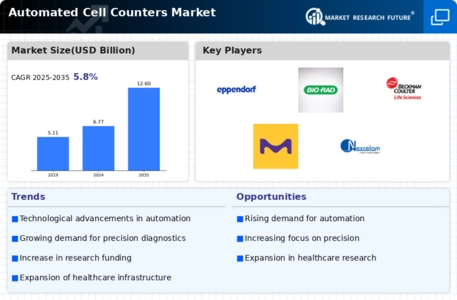Market Share
Automated Cell Counters Market Share Analysis
The Automated Cell Counters market, a pivotal segment within the broader life sciences industry, is witnessing intense competition as companies strive to establish and expand their market share. In this dynamic landscape, market share positioning strategies play a crucial role in determining the success and sustainability of businesses operating in this sector. Companies in the Automated Cell Counters market employ various strategies to gain a competitive edge and enhance their market presence.
One prevalent strategy involves product differentiation, where companies focus on offering unique features and capabilities in their automated cell counting devices. This approach aims to address specific needs and preferences of end-users, such as researchers and healthcare professionals. By providing innovative solutions with advanced functionalities, companies can attract a niche market segment and distinguish themselves from competitors. For instance, some automated cell counters may incorporate advanced imaging technologies or user-friendly interfaces to simplify the cell counting process, thus gaining favor among users seeking efficiency and precision.
Another key market share positioning strategy is pricing. Companies often adopt different pricing models to target specific customer segments based on their budget constraints and preferences. Some businesses may opt for a premium pricing strategy, positioning their automated cell counters as high-end, sophisticated instruments with advanced features. This appeals to customers who prioritize quality and are willing to pay a premium for top-notch performance. On the other hand, companies pursuing a cost leadership strategy may focus on providing cost-effective solutions without compromising on essential functionalities, capturing the attention of budget-conscious customers.
Strategic partnerships and collaborations also emerge as significant drivers in the market share positioning of Automated Cell Counters. Companies may enter into collaborations with research institutions, healthcare providers, or industry leaders to expand their market reach and enhance their credibility. By aligning with key stakeholders, businesses can leverage their partners' expertise and resources, gaining a competitive advantage in terms of market knowledge, distribution channels, and customer relationships.
Moreover, an emphasis on market segmentation allows companies to tailor their products to specific customer needs. Understanding the diverse requirements of different end-users, such as laboratories, academic institutions, or pharmaceutical companies, enables businesses to develop targeted marketing strategies. By customizing their offerings, companies can effectively address the unique challenges faced by each segment, thus strengthening their market position.
Customer-centric approaches, such as after-sales support and service, also contribute significantly to market share positioning. Companies that prioritize customer satisfaction by offering comprehensive training programs, prompt technical assistance, and regular maintenance services can build strong relationships with their clients. A satisfied customer base is likely to be loyal and may act as brand advocates, positively impacting the company's market share over the long term.









Leave a Comment